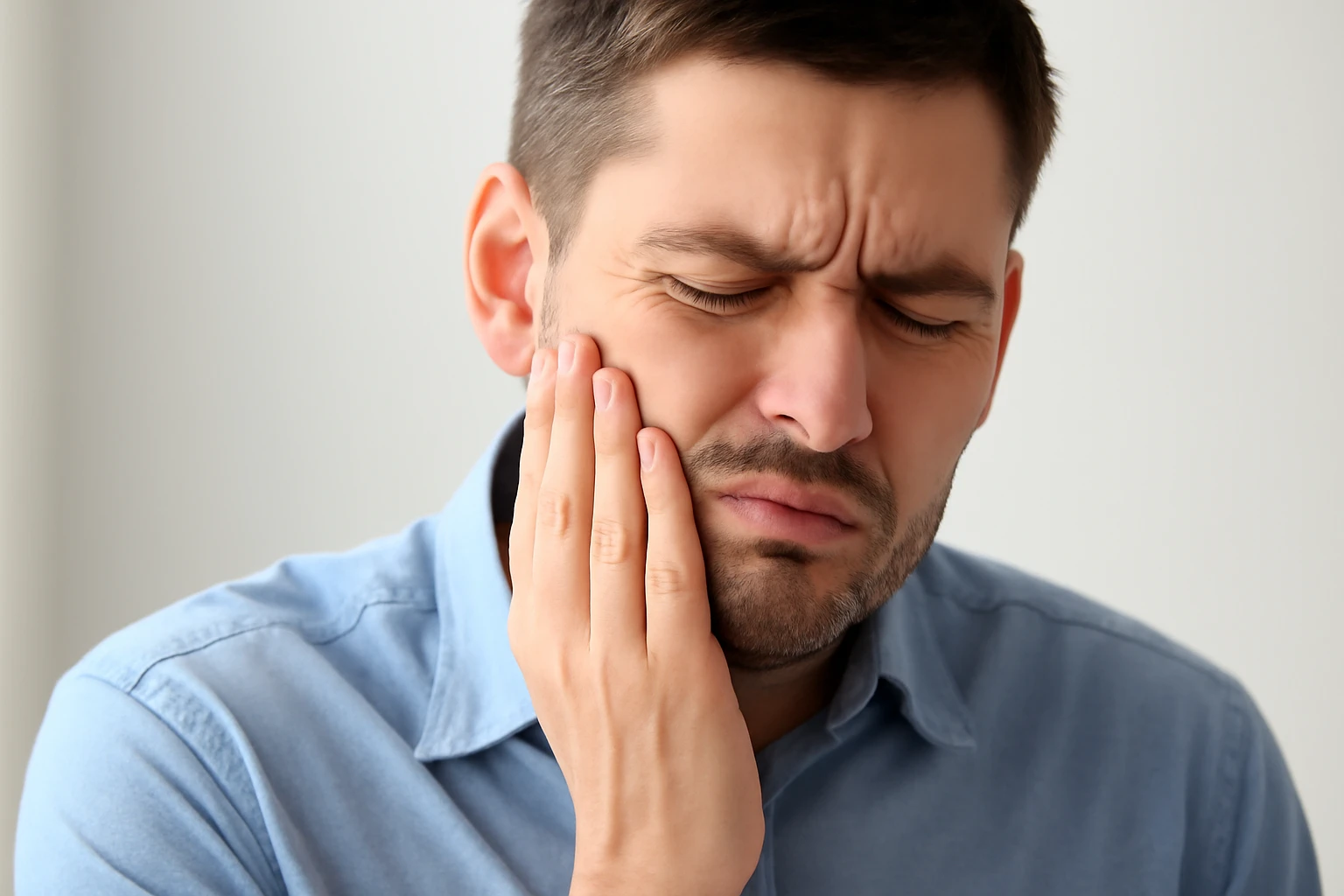Preventing Tooth Pain: Tips for Long-Term Oral Health
Causes of Tooth Pain
Tooth pain is a common issue that can range from mild discomfort to severe, persistent pain. It often signals an underlying dental problem, such as cavities, infections, or trauma. Recognizing the causes and symptoms of tooth pain is essential for identifying the right course of treatment and preventing further complications.
Common Causes of Tooth Pain
- Dental Cavities: Tooth decay damages the hard outer surface of the tooth, leading to pain especially when the decay reaches the dentin or the pulp.
- Infections and Abscesses: Bacterial infections inside the tooth or at its root can cause inflammation, pressure build-up, and significant pain in the surrounding tissues.
- Trauma or Injury: Damage from physical injury, biting hard objects, or accidents can result in fractures, nerve damage or compromised tooth structure.
- Gum Disease & Gum Recession: Inflammation of the gums or receding gum lines expose the tooth root or sensitive areas, often provoking pain to hot/cold stimuli.
- Cracks in Teeth / Worn Fillings: Even fine cracks in a tooth or broken/flawed fillings can expose nerves or the pulp chamber to irritants, causing discomfort.
- Teeth Grinding (Bruxism) & Bite Issues: Chronic grinding or incorrect bite alignment can cause micro-fractures, enamel wear, and pain in the tooth or jaw joint.
- Wisdom Teeth & Impaction: Emerging or impacted wisdom teeth can exert pressure, trap food/bacteria, or misalign adjacent teeth, leading to pain.
- Genetic or Developmental Factors: Some individuals may have thinner enamel, more vulnerable nerve supply or other structural predispositions that make them more prone to pain.
- Referred Pain: Occasionally, pain felt in a tooth is actually originating from another site, such as the jaw joint (TMJ), sinus infection, or ear issues.
Because multiple causes can overlap, a thorough dental evaluation is crucial when pain persists or worsens.
Symptoms of Tooth Pain
Tooth pain can manifest in various ways depending on the underlying cause. Recognizing the symptoms of tooth pain is essential for determining the severity of the issue and the appropriate steps for treatment.
Pain Characteristics
- Dull Ache: A persistent, low-level discomfort often linked to chronic decay or early pulp involvement.
- Sharp, Sudden Pain: Often triggered by hot/cold, biting down, or designates a crack, exposed nerve or acute inflammation.
- Throbbing or Pulsating Sensation: Commonly seen in abscesses or infections where pressure and inflammation are present.
Sensitivity and Swelling
- Sensitivity: Teeth may become sensitive especially to hot, cold or sweet foods when the enamel/dentin is compromised.
- Swelling or Redness: Gums may swell, cheek may puff out, or you may notice gum redness, indicating infection or gum disease.
Additional Warning Signs
- Visible Damage: Cracks, chips or missing fillings may accompany pain and indicate structural issues.
- Pain when Biting or Chewing: Indicates possible fracture or internal damage to the tooth.
- Pain at Night or When Lying Down: A sign of increased blood flow or pressure on the pulp when horizontal.
- Fever, Bad Taste or Swollen Lymph Nodes: Suggests infection that may be spreading beyond the tooth.
If any of these signs appear, early dental assessment is strongly advised.
How Tooth Pain Is Diagnosed
Diagnosing the cause of tooth pain is essential for determining the appropriate treatment and addressing the underlying issue. The diagnostic process typically begins with a clinical examination and may require additional imaging techniques.
Clinical Examination
A dentist will perform a thorough examination of your teeth, gums, and surrounding tissues to identify the source of pain. The dentist will look for signs of cavities, gum disease, or other visible damage. They may gently probe the affected tooth to assess sensitivity and check for swelling or signs of infection.
Imaging and X-Rays
If the cause of the pain is not immediately apparent, X-rays or other imaging may be taken. These help detect hidden cavities, fractures, root infections, or bone involvement.
Additional Diagnostic Tests
- Sensitivity tests (cold/hot stimulus) to check pulp vitality.
- Assessment of bite, jaw alignment or TMJ function for referred pain.
- Medical history review for systemic issues (e.g., sinusitis) that may mimic tooth pain.
Accurate diagnosis ensures that treatment is targeted and effective, preventing unnecessary procedures.
Treatment Options for Tooth Pain
Tooth pain can be managed in various ways depending on the severity of the condition. There are effective options for relieving pain at home, as well as professional treatments available through dental care providers.
At-Home Relief Measures
- Over-the-Counter Pain Relievers: Ibuprofen or acetaminophen may provide temporary relief while awaiting dental care.
- Cold Compress: Applying a cold pack to the outside of the cheek can reduce swelling and numb the area.
- Warm Salt-Water Rinse: A gentle rinse (1 tsp salt in warm water) can help reduce bacteria and soothe the area.
- Avoiding Irritants: Avoid very hot, cold, sweet foods or biting on the affected side to prevent aggravation.
These measures are temporary and do not replace the need for professional treatment if the problem is underlying.
Professional Dental Treatments
Once the cause is identified, the dentist will recommend appropriate treatment:
- Fillings: To repair cavities or remove decay before it extends further.
- Root Canal Therapy: When the pulp is infected or damaged irreversibly; removes the infected tissue and seals the root.
- Extractions: In cases where a tooth is severely damaged or infected and cannot be saved.
- Periodontal Treatment: If gum disease is a factor, special cleaning or surgery may be needed.
- Night Guards or Bite Adjustment: For grinding/clenching-related damage, a custom guard may prevent further pain.
- Antibiotics: When infection and swelling are present, antibiotics may be prescribed to assist the dental treatment.
When to Seek Immediate Care
Certain symptoms require prompt dental or medical attention:
- Severe pain that doesn’t respond to pain relievers
- Swelling in the face or neck, difficulty breathing or swallowing
- Fever or signs of systemic infection
- Persistent pain lasting more than 1-2 days without improvement
Preventing Tooth Pain: Long-Term Care Tips
Preventing tooth pain in the future involves a combination of proper oral hygiene, regular dental visits, and lifestyle changes. By following a few simple guidelines, you can significantly reduce the risk of tooth pain caused by cavities, infections, and other dental issues.
Proper Oral Hygiene
- Brushing: Brush at least twice a day with fluoride toothpaste to remove food particles and plaque.
- Flossing: Floss daily to remove plaque between teeth, where a toothbrush can’t reach.
- Mouthwash: Use an antibacterial mouthwash to kill bacteria and freshen breath.
Regular Dental Check-Ups
Routine dental visits are essential for detecting early signs of tooth decay, gum disease or other issues that could lead to pain. Early intervention can save you from more invasive treatments later.
Diet and Lifestyle Considerations
- Avoid Sugary Foods: Sugary foods feed harmful bacteria that can lead to decay and enamel erosion.
- Avoid Tobacco: Tobacco use increases the risk of gum disease and oral infections.
- Use Protective Gear: Wear mouthguards during contact sports to prevent trauma-related tooth pain.
- Manage Stress and Grinding: Stress reduction can lower the chance of clenching or grinding teeth, which in turn helps reduce wear and pain.
Quick Summary
- Tooth pain is often caused by dental cavities, infections, or trauma.
- Poor oral hygiene, grinding or genetic factors may lead to tooth disorders.
- Tooth pain can present as sharp, throbbing, or dull discomfort.
- Symptoms may include sensitivity, visible damage or swelling of the gums.
- Diagnosis typically involves clinical examination and imaging tests.
- Home remedies provide temporary relief but do not replace professional care.
- Regular brushing, flossing and dental check-ups are crucial for preventing tooth pain.
- Seek prompt care when pain is severe, lasts more than a day or is associated with swelling or fever.
Frequently Asked Questions
- What causes tooth pain?
- Cavities, infections, trauma, gum disease or cracks are common causes.
- How can I relieve tooth pain at home?
- Over-the-counter pain relievers and cold compresses may provide temporary comfort until you can see a dentist.
- When should I see a dentist?
- If pain persists over 24-48 hours, is severe, or is accompanied by swelling, fever or difficulty swallowing.
- Can tooth pain be prevented?
- Yes – with good oral hygiene (brush, floss, rinse), regular dental visits and avoiding risk factors like sugar and tobacco.













